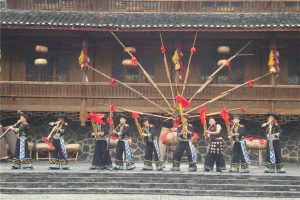
History of Yi Ethnic Minority
The Yi language belongs to the Tibetan-Myanmese Language Group of the Chinese-Tibetan Language Family, and the Yis speak six dialects. Many Yis in Yunnan, Guizhou and Guangxi know the Han (standard Chinese or Mandarin) language. The Yis used to have a syllabic script called the old Yi language, which was formed in the 13th century. It is estimated that the extant old Yi script has about 10,000 words, of which 1,000 are words of everyday use. A number of works of history, literature and medicine as well as genealogies of the ruling families written in the old Yi script are still seen in most Yi areas. Many stone tablets and steles carved in the old Yi script remain intact. Since the old Yi language is not consistent in word form and pronunciation, it was reformed after liberation for use in books and newspapers.

Historical records written in the Han and the old Yi languages show that the ancestors of the Yi, Bai, Naxi, Lahu and Lisu ethnic groups were closely related with ancient Di and Qiang people in west China. In the period between the 2nd century B.C. and the early Christian era, the activities of the ancient Yis centered around the areas of Dianchi in Yunnan and Qiongdou in Sichuan. After the 3rd century, the ancient Yis extended their activities from the Anning River valley, the Jinsha River, the Dianchi Lake and the Ailao Mountains to northeastern Yunnan, southern Yunnan, northwestern Guizhou and northwestern Guangxi.
In the Eastern Han (25-220), Wei (220-265) and Jin (265-420) dynasties, inhabitants in these areas came to be known as “Yi,” the character for which meant “barbarian.” After the Jin Dynasty, the Yis of the clan named Cuan became rulers of the Dianchi area, northeastern Yunnan and the Honghe (Red) River area. Later those places were called “Cuan areas” which fell into the east and west parts. The inhabitants there belonged to tribes speaking the Yi language.
In the Tang and Song dynasties, the Yis living in “East Cuan” were called “Wumans.” In different historical periods, “Cuan” changed from the surname of a clan to the name of a place, and further to the name of a tribe. In the Yuan and Ming dynasties, “Cuan” was often used to refer to the Yis. After the Yuan Dynasty, part of “Cuan” acquired the name “Luoluo” (Ngolok), which probably originated from “Luluman,” one of the seven “Wuman” tribes in the Tang Dynasty. From that time on, most Yis called themselves “Luoluo,” although many different appellations existed. This name lasted from the Ming and Qing dynasties till liberation.

Ancient Yis experienced a long primitive society in the Stone Age. Legends and records written in the old Yi script show that the Yis went through a matriarchal age in ancient times. Annals of the Yis in the Southwest records that the Yi people in ancient times “only knew mothers and not fathers,” and that “women ruled for six generations in a row.” Patriarchy came into being at least 2,000 years ago.
Roughly in the 2nd and 3rd centuries B.C., the Yis living around the Dianchi Lake in Yunnan entered class society. In the early Han Dynasty, prefectures were set up in this area, and the chief of the Yi people was granted the title “King of Dian” with a seal. Around the 8th century, a slave state named “Nanzhao” was established in the northern Ailao Mountain and the Erhai areas, with the Yis as the main body and the Bai and Naxi nationalities included. The head of the state was granted the title “King of Yunnan.” In the same period, “Luodian” and other groups of slave owners and regimes appeared in the Yi areas in Guizhou. In 937, the state of “Dali” superseded “Nanzhao,” when it collapsed under the blows of slave and peasant uprisings. From then on, the slave system of the Yis in Yunnan gradually disintegrated.
After the 13th century, “Dali” and “Luodian” were conquered one after the other by the Yuan Dynasty, which set up regional, prefectural and county governments and military and civil administrations in the Yi areas in Yunnan, Guizhou and Sichuan, appointing hereditary headmen to rule the local inhabitants. By the end of the Yuan Dynasty, the feudal economy of the Yi landlords in Yunnan had developed rapidly, but remnants of the manorial economy and slavery still existed to varying extents in the secluded areas. The Ming Dynasty used both administrative officials from elsewhere and local hereditary headmen, and some of the governments consisted of both types of administrators, expanding the influence of the feudal landlord economy. The large number of Han immigrants also promoted economic growth in the Li areas. The Qing Dynasty abolished the system of appointing hereditary headmen and confirmed the appointment of administrative officials. This enhanced its direct rule over the Yi areas, hastened the disintegration of the manorial economy and firmly established the feudal landlord economy.
















